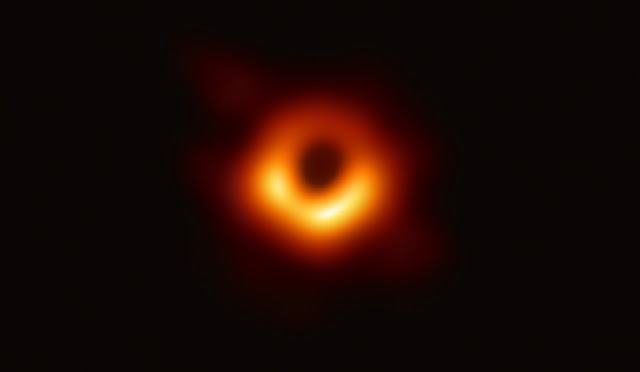Black hole first ever image
WASHINGTON, April 10 (Reuters) - An international scientific team on Wednesday announced a milestone in astrophysics - the first-ever photo of a black hole - using a global network of telescopes to gain insight into celestial objects with gravitational fields so strong no matter or light can escape.
The research was conducted by the Event Horizon Telescope (EHT) project, an international collaboration begun in 2012 to try to directly observe the immediate environment of a black hole using a global network of Earth-based telescopes. The announcement was made in simultaneous news conferences in Washington, Brussels, Santiago, Shanghai, Taipei and Tokyo.
Here it is, humanity, the first-ever photo of a black hole, taken by an international collaboration of scientists called the Event Horizon Telescope.
This is a picture of the supermassive black hole at the center of the Messier 87 galaxy, which is 53.49 million light-years away. The black hole at its center is massive, some 6.5 billion times the mass of our sun, all contained in a single point of infinite density.
 |
| The Event Horizon Telescope: Global Array |
“We exposed part of the universe we thought was invisible before,” Sheperd Doeleman, director of the Event Horizon Telescope, said at the press conference announcing the image Wednesday. The announcement coincided with the publication of six studies on the effort in The Astrophysical Journal Letters. “As with all great discoveries, this is just the beginning.”
At the center of this image is the M87 black hole. The visible reddish and white light surrounding it is material being destroyed by the immense gravity of the black hole. That light encircles the photon orbit, a region beyond which light could conceivably escape from but is unlikely to. Within that photon orbit is the event horizon, the region beyond which no light can escape. The size and shape of this black hole, the researchers say, is exactly as predicted in Einstein’s theories of gravity.
As you look at this image, know that this isn’t an object. This is a shadow, a sink. The light in the center gets sucked out of our view irretrievably. The absence in the image means something has left our observable universe. It’s a truly remarkable moment for humans to be able to see something so enigmatic, so far away, and so incredibly difficult to capture.
“As an astrophysicist, this is a thrilling day for me. It’s easy for us to forget that none of us have actually seen one,” said France Córdova, director of the National Science Foundation, which helped fund the project. The image “did bring tears to my eyes; it’s an amazing image.”
How scientists took advantage of a “cosmic opportunity” to photograph a black hole
Black holes are black because the singularity sucks up all the light around it. “Every ray of light, every photon that goes near the black hole, actually bends toward the black hole and gets completely removed from the universe as we know it,” Dimitrios Psaltis, an astrophysicist at the University of Arizona and one of the lead scientists on the effort, says.
In this way, the black hole casts a shadow on its surroundings. “Even though the black hole does not have a surface, it removes all the light that goes near it, so it behaves like a very dark object,” he explains.
There’s a reason we’ve never seen a picture of a black hole until today. It’s not just that black holes are dark; they’re actually very small, and are surrounded by bright gas and swirling material (the M87 black hole shoots out a jet of hot plasma that’s more than 4,000 light-years long).
 |
| M-87 galaxy |
In science-speak, the shadow cast by the M87 black hole is around 40 microarcseconds wide when viewed from the Earth. An arcsecond is 1/3600th of a degree. And there are 1 million microarcseconds in an arcsecond. Again: The shadow cast by the black hole is tiny. Compared to the full moon, the shadow cast by the M87 black hole is 46.5 million times smaller. Taking a picture of the shadow cast by a supermassive black hole is like taking a photo of a quarter in Los Angeles all the way from Washington, DC.
To take a picture of something that small, you need a huge telescope, one the size of the Earth. The image of the Messier 87 galaxy released today is the result of a seven-year international collaboration, the Event Horizon Telescope, to build that Earth-size telescope, involving 200 scientists and eight observatories around the world.
The Event Horizon Telescope, explained
The critical moment came in April 2017, when eight radio telescopes located in Antarctica, Greenland, South America, North America, Hawaii, and Europe all pointed their dishes to the black hole in the center of our galaxy, and to the one at the center of Messier 87. These were the largest black holes they believed they could get a clear shot of in April. Data on the black hole at the center of our galaxy has yet to be released.
They were looking out for the narrow band of radiation that’s expected to be emitted from the bright ring of material around the black hole. And in the middle of the bright ring, they hoped to see the silhouette of the black hole itself.
As the Earth turned, they were able to take advantage of what Doeleman called a “cosmic opportunity,” to capture radio waves emitted from the black hole and eventually create the image we see today.
Each telescope ultimately captured an enormous amount of data that needed to be combined to reveal the image of the center of the galaxy. As the National Science Foundation explains, these eight telescopes were turned into a virtual giant parabolic dish.
Think about a simple mirror telescope. In it, the curved surface of a mirror reflects light back to a central point, where an image is brought into focus. The Event Horizon Telescope does a similar thing. “When the EHT sites are synchronized, their recordings can later be perfectly aligned in the same way that the mirror aligns the optical light,” the National Science Foundation explains in a video.
The actual math involved in stitching together an image is very similar to what an MRI scanner or a CAT scan does when mapping the inside your body, Psaltis says. “A CAT scan takes X-ray pictures of all around your head and then uses mathematics to unravel it and see what is inside your head.” The Event Horizon Telescope did a similar thing with the black hole.
But this synchronization is really hard. Part of the reason this announcement has been two years in the making is because the data files were too big to be transferred by digital means. The hard drives had to be flown from the observatories to get processed. And the data set in Antarctica was inaccessible for months due to harsh winter conditions.
Another reason is that the scientists need to account for Earth’s rotation. Because Earth rotates, the individual observatories making up the Event Horizon Telescope are moving too, introducing a type of blur into the data. It took extremely precise atomic clocks — precise to a fraction of a trillionth of a second — at each of the observatory sites to ensure all the data would line up and the resulting image would be clear.
For this image to exist, a huge number of factors had to align just right
“So many things had to go right for this image to exist,” Seth Fletcher, the author of Einstein’s Shadow, a book chronicling the Event Horizon Telescope effort, explains in the book.
There had to be some radiation emanating from the outskirts of the black hole, and it had to reach Earth without being knocked off course or occluded by a celestial object. It’s a coincidence that the right size of telescope to see this black hole is the size of the Earth. If astronomers needed a telescope larger than Earth, they’d be out of luck.
Then comes the human collaboration: Eight observatories all over the world had to sync up their clocks to an absurdly specific degree.
And then there’s just luck. “You have to have clear weather in all of those places — eight different sites with clear weather on a given night at a time when the Earth is oriented in such a way that all of those telescopes can see the black hole simultaneously,” Fletcher says.
This one image represents all of that coming together.
“The biggest excitement in my mind is the discovery, the eureka place,” Psaltis says. “I’m sure many other times in human history, people saw something for the first time ... and what you see, you cannot unsee. This is it for the rest of humanity, for the rest of human history.”
What’s next? Well, perhaps scientists can build a telescope even larger than Earth, by adding space telescopes to the Event Horizon array, and see the even smaller black holes closer to our solar system. “And this way we’ll be able to do similar experiments with maybe 10, 20, or 30 black holes in the nearby universe,” Psaltis says.
Black holes are important to study because they represent the most extreme areas of our universe, where fundamental theories like general relativity and quantum mechanics are put to the ultimate test. This photo is just the beginning.
Source via Web & Vox




Comments
Post a Comment